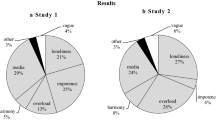Abstract
Adults appear to cry only during a “recovery” phase following a period of arousal. Depending on the perturbation that caused the arousal, the first phase is sometimes described by them in positive terms (e.g., excitement, anticipation) and sometimes in negative terms (loss, threat). However, the tears always seem to be associated with tension reduction and signify that a second event has permitted the system to shift into recovery. In this sense, all tears can be thought of as “tears of joy” they follow the same mechanism regardless of the tone of the initiating circumstances. To provide evidence for this point of view the responses of 11 individuals (including 2 filmmakers) toThe Miracle Worker were analyzed. Their responses supported the hypothesis that crying occurs when a psychological barrier or perturbation “disappears”—it signifies recovery and adaptation rather than the continuation of distress or arousal.
Similar content being viewed by others
References
Berlyne, D. E. Curiosity and learning.Motivation and Emotion 1978,2 97–169.
Bowlby, J.Attachment and loss (Vol. 1). London: Hogarth Press and Institute of Psychoanalysis, 1969.
Feldman, S. S. Crying at the happy ending.Journal of the American Psychoanalytic Association 1956,4 477–485.
Flavell, J.The developmental psychology of Jean Piaget. New York: Van Nostrand, 1963.
Gibson, W.The miracle worker. New York: Bantam Books, 1962.
Heilbrunn, G. On weeping.Psychoanalytic Quarterly 1955,24 245–255.
Jackins, H.The human side of human beings. Seattle: Rational Island Publishers, 1965.
Kagan, J. On the need for relativism.American Psychologist 1967,22 131–143.
Kahn, M. The physiology of catharsis.Journal of Personality and Social Psychology 1966,3 278–286.
Knight, E. Lassie Come Home.Saturday Evening Post, December 17, 1938, pp. 10–13; 50–55.
Littenberg, R., Tulkin, S. R., & Kagan, J. Cognitive components of separation anxiety.Developmental Psychology 1971,4 387–388.
Mandler, G. The interruption of behavior. In D. Levine (Ed.),Nebraska symposium on motivation. Lincoln: University of Nebraska Press, 1964.
Meir, Golda.My life. New York: Dell, 1975.
Nichols, M., & Zax, M.Catharsis in psychotherapy. New York: Gardner Press, 1977.
Nisbett, R. E., & Wilson, T. D. Telling more than we know: Verbal reports on mental processes.Psychological Review 1977,84 231–259.
Penn, Arthur.The miracle worker. Hollywood: United Artists, 1962. (Film)
Perls, F. S.Ego, hunger and aggression. New York: Vintage Books, 1969.
Rodgers, R., & Hammerstein, O., 2nd.The king and I. New York: Random House, 1961.
Sadoff, R. L. On the nature of crying and weeping.Psychiatric Quarterly 1966,44 490–503.
Shultz, T. R. The role of incongruity and resolution in children's appreciation of cartoon humor.Journal of Experimental Child Psychology 1972,13 456–457.
Sroufe, L. A., Waters, E., & Matas, L. Contextual determinants of infant affective responses. In M. Lewis & G. Rosenblum (Eds.),Origins of fear. New York: Wiley, 1974.
Suls, J. M. A two-stage model for the appreciation of jokes and cartoons: An information-processing analysis. In J. H. Goldstein & P. E. McGhee (Eds.),The psychology of humor: Theoretical perspectives and empirical issues. New York: Academic Press, 1972.
Tomkins, S. The positive affects.Affect, imagery, consciousness (Vol. 1). New York: Springer, 1962.
Weiss, J. Crying at the happy ending.Psychoanalytic Review 1952,39 338.
Author information
Authors and Affiliations
Rights and permissions
About this article
Cite this article
Efran, J.S., Spangler, T.J. Why grown-ups cry. Motiv Emot 3, 63–72 (1979). https://doi.org/10.1007/BF00994161
Issue Date:
DOI: https://doi.org/10.1007/BF00994161




